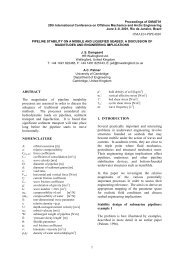Cantilever-like micromechanical sensors - Artek
Cantilever-like micromechanical sensors - Artek
Cantilever-like micromechanical sensors - Artek
Create successful ePaper yourself
Turn your PDF publications into a flip-book with our unique Google optimized e-Paper software.
Rep. Prog. Phys. 74 (2011) 036101 A Boisen et al<br />
Figure 15. SEM images of fabricated poly-silicon cantilever structures on a CMOS chip. (a) Top view image of a defined cantilever<br />
structure. The cantilever is excited into lateral resonance by applying an ac and dc voltage between the driver electrode and the cantilever.<br />
The cantilever is connected to a comb capacitor in order to polarize the CMOS circuitry. (b) Tilted view image of a 20 µm long, 425 nm<br />
wide and 600 nm thick cantilever [179].<br />
Figure 16. Series of four AlN beams, with undercut lengths ranging<br />
from 3.9 to 5.6 mm. The beams are 0.17 mm thick and the widths<br />
are 0.2 mm, increasing to widths of 2.4 mm at either end [195].<br />
aluminium nitride cantilevers have been realized where the<br />
aluminium is sandwiched between two electrodes placed at<br />
the top and bottom of the cantilever. Thereby it is possible<br />
to drive the cantilever and to bias the cantilever with a dc<br />
current. It has been demonstrated that it is possible to tune<br />
the resonant frequency of the device with 34 kHz V −1 and the<br />
same piezoelectric layer has also been used for the read-out of<br />
the signal.<br />
The challenge of this technique is that most piezoelectric<br />
materials are difficult to work with and they are not all<br />
cleanroom compatible. The read-out has the advantage<br />
of being easily scalable and with low power consumption.<br />
Cleanroom compatible materials such as aluminium nitride<br />
with a high stiffness and with interesting electrical properties<br />
will probably be further explored in the coming years.<br />
4.4. Piezoresistive read-out<br />
In piezoresistive cantilever sensing each cantilever has an<br />
integrated resistor which has piezoresistive properties. Due<br />
to the piezoresistive property the resistance changes when<br />
the cantilever bends. Thus, by an electrical measurement<br />
of a resistance change the deflection of the cantilever can be<br />
determined. The benefits of this method are that the principle<br />
works well in both liquid and gas phase and large arrays can<br />
17<br />
be realized and read-out. Also, the technique is applicable for<br />
static as well as dynamic measurements. Sensing the cantilever<br />
deflection by integrating piezoresistors on the cantilever was<br />
initially developed by two groups for AFM imaging; Tortonese<br />
et al at Stanford University [197] and Rangelow et al at Kassel<br />
University [198]. AFM cantilevers with piezoresistive readout<br />
are available through Seiko [199]. These cantilevers,<br />
originally optimized for AFM, have, for example, been used<br />
for the detection of thermal expansion in exotic new materials<br />
such as alpha uranium [200].<br />
In 2000 the first cantilever-based sensing experiments<br />
using piezoresistive cantilevers were reported [20, 55]. Similar<br />
cantilever <strong>sensors</strong> have, since 2001, been commercially<br />
available through the company Cantion A/S. Here the<br />
cantilevers are placed in arrays of either 4 or 16. Such<br />
arrays have, for example, been used to monitor consolidated<br />
bioprocessing by detecting ethanol and glucose [201] and<br />
saccharide [202]. Recently, similar piezoresistive cantilever<br />
arrays have been developed and used for gas sensing [203].<br />
Typically, a reference and a measuring cantilever are<br />
connected with two external resistors to form a Wheatstone<br />
bridge configuration [20, 204, 205]. In this way an output<br />
signal is only recorded when there is a difference in the<br />
deflection of the two cantilevers and the noise is reduced<br />
significantly. This measuring principle is shown schematically<br />
in figure 17.<br />
Currently, several groups pursue the development of<br />
piezoresistive read-out [206, 207]. In the group of Pruit<br />
et al the read-out has been optimized for force sensing in<br />
living organisms and basic work on optimizing the read-out<br />
is conducted [208, 209]. The piezoresistive cantilevers can<br />
be integrated with CMOS for signal amplification and signal<br />
processing [210, 211].<br />
In recent work, gold has been used as the integrated<br />
strain gauge. First for implementation in micrometre-sized<br />
polymer cantilevers [125, 150] and later for the realization of<br />
piezoresistive silicon carbide nanometre-sized cantilevers [33].<br />
The small silicon carbide devices have been optimized and<br />
used for mass sensing. An impressive mass resolution of 1 ag<br />
is reported. Even though the gauge factor of gold is low the<br />
final mass resolution is high because of the low electrical noise<br />
in the gold film.





